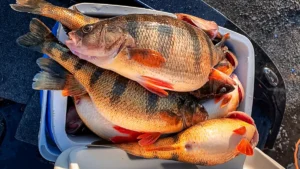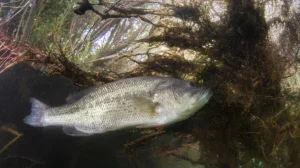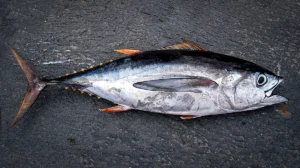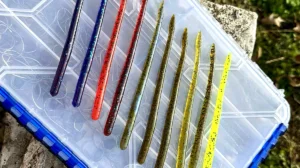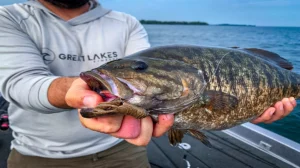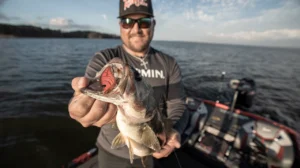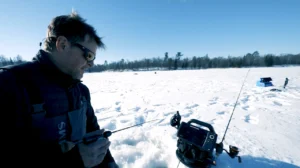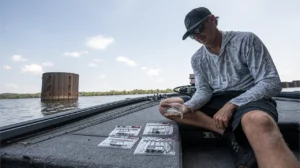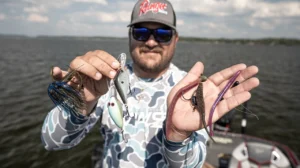In this comprehensive video, Mike McClelland dives into how he uses underspins to catch suspended prespawn bass. As bass transition from winter patterns to spawning behaviors, McClelland highlights the importance of finding offshore fish before they disperse along the shoreline. Making target casts with forward-facing sonar proves hard to beat at this time of the year.
Featured Product
- JIG – Gamakatsu Underspin Head Mini, 3/8-ounce: Buy at Tackle Warehouse | Buy at FishUSA
- PLASTIC – Big Bite Baits Jointed Jerk Minnow: Buy at Tackle Warehouse | Buy at FishUSA
- ROD – Falcon Cara Casting Rod, 7’2” Medium Heavy – Fast: Buy at Bass Pro Shops | Buy at Tackle Warehouse
- REEL – Johnny Morris Platinum Signature Baitcast Reel, 6.8:1: Buy at Bass Pro Shops
- LINE – Sunline Super FC Sniper Fluorocarbon Line, 10-pound: Buy at Bass Pro Shops | Buy at Tackle Warehouse | Buy at FishUSA
Understanding Prespawn Bass Behavior
During the prespawn period, bass migrate from deeper winter habitats to shallower spawning areas where lures like jerkbaits rein supreme. This transition often finds them suspended in the water column, actively feeding on baitfish. McClelland underscores the necessity of identifying these behavioral patterns to target bass during this phase effectively.
The Effectiveness of Underspins
Underspins are particularly effective during the prespawn phase due to their ability to mimic the flash and vibration of baitfish. This lure’s versatility allows anglers to cover various depths and adapt to changing conditions. McClelland emphasizes that underspins can be fished at different speeds and depths, making them suitable for targeting active and lethargic bass.
Rigging and Presentation Techniques
McClelland advises selecting underspin sizes and trailers based on bass activity levels. For less aggressive fish, a lighter head with a paddle tail swimbait allows for a slower retrieve, keeping the lure in the strike zone longer. Conversely, a heavier head with a streamlined trailer suits more aggressive fish, enabling a faster retrieve. Incorporating pauses and subtle jerks during retrieval can trigger reaction strikes, as these movements imitate the erratic behavior of distressed baitfish.
Utilizing Electronics and Observing Natural Indicators
Using his mapping in conjunction with Garmin LiveScope helps McClelland locate suspended bass and baitfish schools. Additionally, observing natural indicators like loons can signal active baitfish areas, as these birds often feed in the same regions where bass are hunting. McClelland emphasizes the importance of paying attention to these natural cues.
By understanding prespawn bass behavior and effectively utilizing underspins, anglers can significantly improve their catch rates during this transitional period. McClelland’s insights provide valuable guidance on adapting techniques and presentations to align with bass activity levels and environmental conditions.
Boat Setup and Misc.
- FISH FINDER – Garmin ECHOMAP Ultra 126sv Chartplotter/Fish Finder Combo: Buy at Bass Pro Shops
- LIVE SONAR – Garmin LiveScope Plus LVS34 – Livescope + LVS34 System: Buy at Bass Pro Shops
- TROLLING MOTOR – Garmin Force Trolling Motor: Buy at Bass Pro Shops
- BOW MOUNTS – BeatDown Outdoors The Ultimate Double Stack: Check out at BD Outdoors
- BOAT – Ranger Z521R Commanche: Check out at Ranger
- SHALLOW WATER ANCHOR – Power-Pole Blade 2.0 Shallow Water Anchor, 10′: Buy at Bass Pro Shops
- MOTOR – Mercury 250hp Pro XS: Check out at Mercury
- HOODY – AFTCO Reaper Hooded Sweatshirt: Buy at Tackle Warehouse


![[VIDEO] Greg Hackney’s Formula for Post-Spawn Bass Success](https://www.wired2fish.com/wp-content/uploads/2025/05/Hackney_Post-Spawn_Bass-300x169.webp)
![[VIDEO] Scanlon’s Guide for Stained Water Spawning Bass](https://www.wired2fish.com/wp-content/uploads/2025/05/scanlon-jig-300x169.webp)
![[VIDEO] Seth Feider’s Prespawn Jig Pattern Explained](https://www.wired2fish.com/wp-content/uploads/2025/04/prespawn-jig-300x169.webp)
